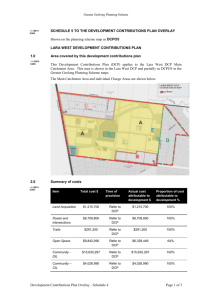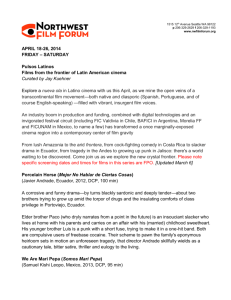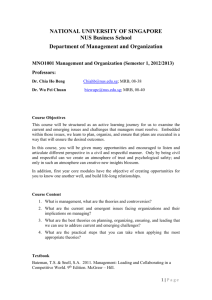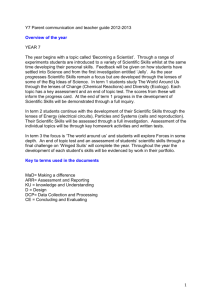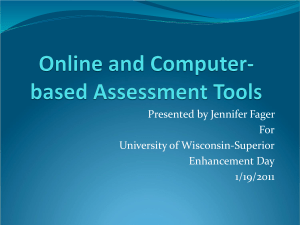Mandate of Design-Centric Programme
advertisement
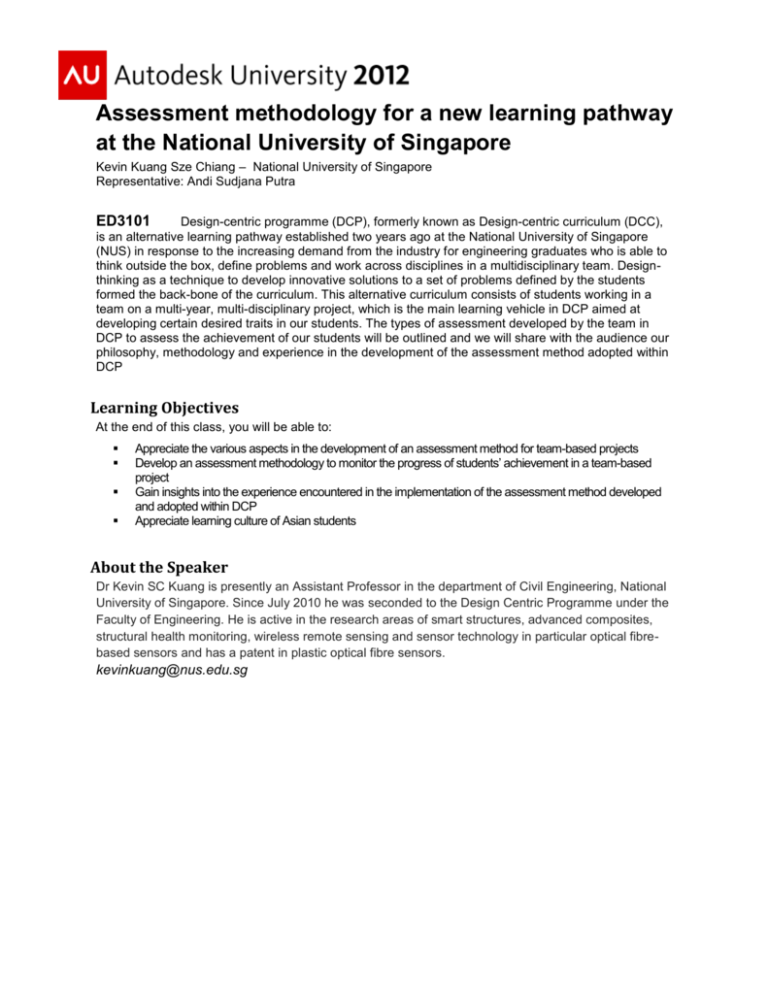
Assessment methodology for a new learning pathway at the National University of Singapore Kevin Kuang Sze Chiang – National University of Singapore Representative: Andi Sudjana Putra ED3101 Design-centric programme (DCP), formerly known as Design-centric curriculum (DCC), is an alternative learning pathway established two years ago at the National University of Singapore (NUS) in response to the increasing demand from the industry for engineering graduates who is able to think outside the box, define problems and work across disciplines in a multidisciplinary team. Designthinking as a technique to develop innovative solutions to a set of problems defined by the students formed the back-bone of the curriculum. This alternative curriculum consists of students working in a team on a multi-year, multi-disciplinary project, which is the main learning vehicle in DCP aimed at developing certain desired traits in our students. The types of assessment developed by the team in DCP to assess the achievement of our students will be outlined and we will share with the audience our philosophy, methodology and experience in the development of the assessment method adopted within DCP Learning Objectives At the end of this class, you will be able to: Appreciate the various aspects in the development of an assessment method for team-based projects Develop an assessment methodology to monitor the progress of students’ achievement in a team-based project Gain insights into the experience encountered in the implementation of the assessment method developed and adopted within DCP Appreciate learning culture of Asian students About the Speaker Dr Kevin SC Kuang is presently an Assistant Professor in the department of Civil Engineering, National University of Singapore. Since July 2010 he was seconded to the Design Centric Programme under the Faculty of Engineering. He is active in the research areas of smart structures, advanced composites, structural health monitoring, wireless remote sensing and sensor technology in particular optical fibrebased sensors and has a patent in plastic optical fibre sensors. kevinkuang@nus.edu.sg ED3101 - Assessment Methodology for a New Learning Pathway at the National University of Singapore Background Located within the Faculty of Engineering, the Engineering Design and Innovation Centre (EDIC) is conceived as a driver for innovation and thought leadership in the broad field of design in the National University of Singapore (NUS). One of the key roles of EDIC is to establish the Design-Centric Programme, a educational platform providing an environment that promotes interaction and exchange of ideas among staff and students of different disciplines to address design projects that require a wide spectrum of expertise. DCP is an alternative learning pathway that was established 2 years ago at the NUS in response to the increasing demand from the industry for engineering graduates who are able to think creatively, define problems, and work across disciplines in a multidisciplinary team. Design-thinking as a technique to develop innovative solutions to a set of problems defined by students forms the backbone of the curriculum. This alternative programme consists of students working in a team on a multi-year, multidisciplinary project that is the main learning vehicle in DCC and is aimed at developing certain desired traits in our students. Autodesk, being at the forefront of software technology for design and education has signed a partnership with EDIC to promote the use, training and certification of Autodesk software for DCC students and have recently resulted in the appointment of two Autodesk Term Professorships in the middle of 2012. Mandate of Design-Centric Programme In view of the increasing demands of the work environment and complexity of problems engineers faced in the field, there have been calls from the industry to further prepare the graduates coming out of institution of higher educations in Singapore. The National University of Singapore, being the flagship tertiary-level educational institution is responding to this challenge by introducing a design-centric approach to educating a new generation of budding engineers. A list of desired traits in the graduates of this alternative educational pathway includes: 1. Possess depth of expertise in their fields of specialization 2. Take on new challenges and be comfortable with tackling the unfamiliar 3. Identify and define problems and formulate innovative and creative solutions 4. Take ideas from conceptualization through to design, implementation and operation 5. Engage in systems-level thinking and deal with complex systems 6. Articulate ideas effectively 7. Lead or work in a multi-disciplinary team 8. Appreciate the cultural and social dimensions of design In the span of 3 to 3.5 years through the course of the programme, the mandate of DCP is to nurture these traits in our students (approximately 10% of the yearly engineering intake) before sending them out into the work environment. The list above, articulated by the present dean of engineering has also resonated with the list of desired learning outcomes documented by the Engineering Accreditation Board (EAB) of the Institute of Engineers Singapore (IES), highlighting the shared perception of what are the important skills and characteristics of the engineering graduates needed to propel the economy forward in view of the stiff global competition. The ability to work together in a multi-disciplinary team at the highest level of competency at all levels of an organization and the ability to handle complex problems seeing them from a systems level are some of the most important traits that we hope to nurture in our students. 2 ED3101 - Assessment Methodology for a New Learning Pathway at the National University of Singapore With this in mind, the DCP has adopted the multi-year, multidisciplinary project work as the vehicle for students to experience learning in a stimulating environment where ideas and implementations are emphasized and encouraged. Through the course of working on the 3-3.5year undergraduate project, the students are expected to lead in its definition, development and delivery of the outcome of their work. The project, being student-led is guided by a panel of supervisors, who are either expert in the field of the project defined or has some other relevant experiences that are deemed to be helpful to the project. In the event where staff within the DCP does not have relevant expertise, faculty members external to EDIC or even NUS will be sought to provide reality-check to the projects proposed by the students. In terms of modular credits, students enrolled in the DCP pathway, will undergo 40 MCs (¼ of their degree work-hours fulfillment) of intensive design-centric modules and training, of which 20 MCs will be credited for their work on the project proper. All the design-centric modules are prepared to support the students’ effort towards the final delivery of their project. The initial stages of the program will focus on the identification of a problem of interest and defining the problem through a process of iterations done by the students to fine-tune their problem and statement and ideation for possible solutions. Design and engineering analysis of the proposed solution will be presented through a series of students’ presentations with critiques from EDIC staff acting as examiners which comprise instructors, lecturers and professors from various technical-disciplinary backgrounds ranging from mechanical, civil, environmental, chemical, bio-engineering, electrical, electronics, design and industrial systems. Formative assessment in the form of feedback to students in the form of oral and written comments are given to students through frequent presentations and interactions between supervisors and students provide invaluable inputs to the students project as they continue to develop their project as well as their ability to defend ideas and solutions when challenged by the staff. Concurrently, summative assessment of the presentation which include assessing their ability to explain the rationale of their project, organization of presentation, grasp of technical content, ability to answer questions and overall delivery in terms of elocution are adopted as the assessment criteria. We do expect to review the criteria and tweak them as the assessment system goes through review by the assessment team lead by the author. Examples of student projects To date there have been in excess of 25 different projects undertaken and the following are projects being pursued by the final year students: Urban Remote Site commuter Morpheus: The Dream Travel Guide Develop and design an Interactive Social Robot for elderly- development of a platform based on Android Energy Efficient Humidity Control System in an Equatorial Country Development of an Electric Hovering Vehicle In the course of their project, students are encouraged to use software provided by Autodesk in their designing process. We have also set-up the IT infrastructure in an attempt to maximize their utilization of what Autodesk has to offer, for example, the use of Autodesk360, where students can collaborate through cloud computing in addition to cloud-based rendering of models. Design Summer Programmes In the summer 2012, from August 23 to July 3, we organized a design-centered summer programme, which was. Here, second and third year students are given the opportunity to participate in an international student symposium. 3 ED3101 - Assessment Methodology for a New Learning Pathway at the National University of Singapore The Design Summer Programme 2012 (DSP2012) being one of the key elements of learning within the DCP pathway took place from 23 July to 3 August 2012. We saw the active participation of sixty-six students in a series of learning activities which included classroom lectures by distinguished speakers, field visits to selected government agencies, working together in multi-disciplinary teams and evening cultural programmes. This year’s DSP theme entitled “Designing Solutions for 2030: An Asian Perspective” was well-received by both NUS and international students who participated in the programme. Following the intensive 2-week event, the feedback given by the participants in the end-of-programme survey have been very encouraging, citing the high educational value of the programme and the excellent opportunities they have had in cross-cultural exchanges, amongst other reasons. Friendships were also forged in the course of the programme and the high level of mutual respect and camaraderie amongst the members in each of the eleven teams were evident. The rigorous 10-day learning journey for the summer programme culminated in the giving of a final presentation by each group, which was judged based on a set of criteria to choose the best performing team. The criteria used are similar to that used for the semester-based presentations which students are expected to do each semester to update on the progress of their project and these include 1. 2. 3. 4. 5. Problem Definition Feasibility of solution Level of innovation Presentation skills Ability to answer questions In the preparation of the scoring sheet to select the best performing team and in view of making the judging less onerous to the panel of judges, the scoring sheet does not contain achievement descriptors. Instead, a simplified scale of 1-5 based on the indication of achievement from Elementary (1) to Intermediate (3) to Advanced (5) was used. The assessment criteria were made known to all the teams to ensure every participant was clear of what was expected from of them right at the start of the project. The panel of judges included the invited speakers from the DSP2012, staff of EDIC as well as the peers of the presenting team (a total of 10 peer-groups assessed the presenting team). The final score of the presentation was based on the average marks of 20 inputs. To encourage the students in their work, a US$300 Amazon voucher was on offer to the best performing group, each group consisted of 6 members. The whole event was brought to a close with a farewell dinner at the NUS staff club where all DSP participants and staff were treated to a fun-filled and memorable time of interaction in an informal setting. A write-up by the External Relations Office of Engineering can be found here: http://www.eng.nus.edu.sg/ero/announcement/web-dccsummer08-12.pdf DCP Assessment Methodology In developing the assessment method for the programme, a team of 6 members was formed to look into how to assess the student’s learning effectively. Where possible existing rubrics available from the Internet, assessment training courses and from other colleagues were adapted to suit our purpose. Care was taken to ensure the assessment criteria to be used in DCP must reflect the desired traits established earlier. The set of desired traits, however, need to be further expanded into a list of expected learning outcomes which could be measured and hence a list of such learning outcomes have been articulated reflecting the skills and ability which DCP hopes to nurture in all the students going through this path of learning. 4 ED3101 - Assessment Methodology for a New Learning Pathway at the National University of Singapore Another important consideration in the development of assessment method we asked ourselves in the process is are 1. What activities are we going to assess? 2. What rubrics do we need to have? 3. Who is/are going to do the assessment? Question 1: In DCP, the learning activities are centered around the multi-year project. In the course of the working on their project, students are expected to keep a log-book documenting their own learning journey. Their learning does not merely focus on arriving at a solution but the process of arriving at a consensus amongst their team members as they work towards a solution based on the collective learning of all members in the team. Typical of any team working on a project, students are also expected to reflect on their contribution, failure, discovery, self-learning, experiences working in a team. Students are also encouraged to do a self-critique and seek out ways to improve on the identified area of failure or work- a short write-up of their reflection in these aspects of their learning journey is expected every semester as part of their overall deliverables. Written technical reports of their work are major elements of the set of deliverables and students are expected to spend a considerable portion of their time on. In conjunction to the report, oral presentations and a final demonstration of the workings of their prototype are make up the set of deliverables expected from students at various stages of their work. The technical reports provide updates of their achievements for the semester which are assessed and graded while at the same time the reports themselves serve as in-progress thesis which will constitute their final report project as fulfillment of their degree requirement. All in-progress reports are group reports (i.e. one report per group) where students combine their individual contributions into writing the report while the final project report expected at the end of the final semester of their course shall be an individual report where although significant portions of the write-up will share the same technical content but expressed in the authors’ own words. The assessment for the final project report will be an individual assessment, partly to satisfy degree conferment requirements and part to avoid over-emphasizing group assessment over individual component. A balance between rewarding group effort and individual effort is important and we are constantly monitoring the relative weightage of the two to prevent free riders (students who get rewarded on account of the work of others) from taking advantage of the system. The compulsory peer assessment report, however, does not carry any marks. From a cultural point of view, a significant proportion of engineering Asian students (local and overseas students from around the region) are less vocal than their western counterparts and have difficulties in doing oral presentations due to a lack of mastery of the (English) language and general lack of confidence in public speaking especially in the presence of professors or figures of authority partly as a result of the cultural emphasis on the giving of respect/honor to individuals of higher seniority (age and/or position). It has also been the observation that engineering students in general are less vocal and less able to project themselves forward due to less exposure to making oral presentations. This has also been the feedback given by the representatives from local industries. In view of this, numerous opportunities have been scheduled into the assessment timeline to allow students to gain more experience in delivering oral presentations. Guidelines and mentoring from supervisors and other DCP staff on improving oral presentations are given to students. In addition, the students also sit-in in each others presentation as part of peer learning. 5 ED3101 - Assessment Methodology for a New Learning Pathway at the National University of Singapore In addition to the reports and presentations, the each project will be assessed in terms of the physical representations of the proposed solutions (which could be a product or a system). The prototype (or model of concepts) A paper-based peer assessment scheme has also adopted in view of the group-based work. 2 types of peer assessment have been introduced, the first being a confidential peers assessment while the other being a open/common peer assessment where members of the team agree amongst themselves on the individual contributions. The supervisors and assessment team will use the information from the peer assessment forms as a reference while the inputs of the supervisor will take precedence over inconsistencies in the information provided by students. This aspect of assessment is admittedly tricky and we are still in the process of improving it. The following table summarizes the deliverables expected from students and the type of deliverables (i.e. either assessed as individual and/or group effort) Presentations(individual & group); Logbook (individual); Personal Reflection Write-up (individual); Thesis Proposal Report (group); Model of Concept/Prototype(group); Final Thesis (individual) and Peer Assessment (individual & group). Question 2: A total of 7 rubrics have been developed to assess the various deliverables described above. Assessment criteria of each rubric used to evaluate the achievements for each deliverable are made transparent to all students. The expected levels of achievement are outlined in the descriptions associated with each assessment criterion for each rubric and are known to both staff and student. This transparency of the assessment criteria and what is expected in order to attain a certain level of achievement (and therefore marks) is deemed to be useful for students. This transparency allows students to be clear on how to improve in the quality of their deliverables and therefore useful in directing student efforts. The weightage (relative emphasis) for each criterion within the rubric, however, is not revealed to the students. This decision was made following past undesirable experiences where many students made appeals to gain their “expected” marks based on their assessments. In addition to being transparent to students, the rubrics were also be developed based on these commonly known guidelines: 1. Clear Expectations- both the teacher and student are completely clear on what is the standards and expectations. 2. Mastery Level- most rubrics we have developed is based on a 5-pointer scale 3. Multi-dimensional- assessment criteria are divided into separate components i.e. each desired skills assessed will be stated in the rubrics on the left-most column e.g. for thesis, score will be given criteria such as (a) Ability to contextualise, (b) Ability to perform analysis of problem, (c) Clarity of problem definition etc. 4. Grade distinction- distinction between grades for each assessment criterion will be made as clear as possible. 5. High but attainable standards/cumulative criteria -in our rubrics, higher scores are given when the project reflects more elements of the learning outcome/desired traits. 6. Allowance for part marks & flexibility-there is no perfect rubrics. There will be occasions where the achievement of the students does not follow the progression of what we expect so the objectivity and accuracy of the assessment rely to a significant degree on the discretion of the examiners. 6 ED3101 - Assessment Methodology for a New Learning Pathway at the National University of Singapore Besides the function of a summative assessment, the rubrics also require examiners to provide textual feedback and comments, constructive critisism to help students to improve on any particular area of concern. When a panel of examiners are involved, all the comments are compiled subsequently by the supervisor and then discussed in more detailed with his or her students. This process also encourages the students to expressed their concerns and views of the results of the assessments. This interaction between supervisors and students promotes further building of rapport between teacher and student. Question 3: In DCP, due to the multi-disciplinary nature of the projects and the fact that the project area may not lie within the expertise of the principle supervisor, we have taken the approach where the students’ work is examined by a panel of examiners comprising DCP staff, professors from various departments in the Faculty as well as experts from outside the University. In addition to the benefit gained by the students with the variety of inputs from these examiners, the inclusion of external staff in the examiners’ panel provides some level of confidence in the results of the assessment compared to one which is fully assessed by internal staff. There have been frequent interaction between DCP staff and external staff (home departments where students originate) to ensure these students are working on problems in the project which fulfill the technical discipline of the home department (i.e. a electrical engineering student in DCP should work on issues in the project with concentration in electrical systems and devices). Professors from various home departments are presently members of the examiners’ panel in DCP and their participantion in the assessment process has been helpful in guiding the students’ project. Another consideration in the inclusion of the staff from home departments is the fact that the module credits ascribed to the DCP project is required to be mapped back to three modules in the home department as DCP does not currently have its own module code. In the present situation, before students received their final grades for the work done in DCP, home department will moderate the marks based on department’s bell curve. Mapping of DCC modules to host department bell curve is currently the most tedious process. However, with the inclusion of the staff from the home department this process is expected to be less problematic in the coming semester. Future plans to assigned separate module codes for DCC work done instead of mapping back to host department is being planned. Some final comments on the rubrics would be useful to summarise our experience in administration of the assessment process in DCP. 1. All assessors must be familiar with the assessment criteria to be able to provide accurate assessment and useful feedback to students 2. Quality of feedback received by students depend to a large degree on the effort of the assessor to provide details, actionable feedback 3. Criticisms from all staff involved in the assessment are vital in improving rubrics. Rubrics always a Work In Progress (with many rounds of iterations) 4. Assessors’ panel made up of multiple staff from DCC and home department representatives has been helpful to minimize variation in assessment due to subjectivity and bias of assessors 7 ED3101 - Assessment Methodology for a New Learning Pathway at the National University of Singapore Concluding remarks 1. The DCP experience is an alternative way of learning, which promotes life-long self-learning and prepared them for the demanding work environment for which they are about to enter. 2. We believe the vehicle to achieve the learning outcome/desired traits is the multi-year, multidisciplinary project which allow students to start working right at the start- to make learning more intentional and impactful. You do and you learn. 3. We believe a team-based approach in project work provides a real-world setting where collaboration and creativity is allows the room to grow and blossom. 4. Tools such as assessment rubrics based on to specific learning outcomes needs to be continuously improve with feedback from all assessors involved in the assessment process and requires understanding the mandate of DCP well. 8



